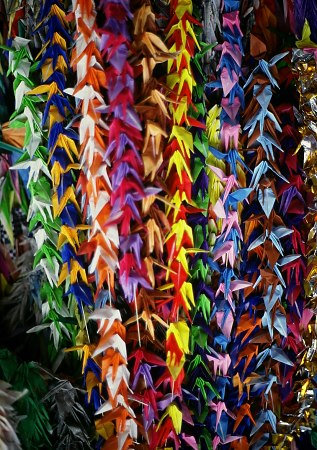
Sadako Sasaki (January 7, 1943 -- October 25, 1955) was a Japanese girl who lived near Misasa Bridge in Hiroshima, Japan. She was only two years old when the atomic bomb was dropped on Hiroshima on August 6, 1945. At the moment of explosion she was at her home, about 1 mile from ground zero. As she grew up, Sadako was a strong, courageous and athletic girl. In 1954, at age eleven, while training for a big race, she became dizzy and fell to the ground. Sadako was diagnosed with leukemia, the "atom bomb disease".
Sadako's best friend told her of an old Japanese legend which said that anyone who folds a thousand origami paper cranes would be granted a wish. Sadako hoped that the gods would grant her a wish to get well so that she could run again. However, it was not just for herself that she wished healing. It is said that what made the girl truly special in her effort was her additional wish to end all such suffering, to bring peace and healing to the victims of the world. She spent fourteen months in the hospital, and she folded over 1,300 paper cranes before dying at the age of twelve. She folded the cranes out of her medicine bottle wrappers and any other paper she could find in hopes of getting better. (A popular version of the story, given in Eleanor Coerr's "Sadako and the Thousand Paper Cranes", is that she fell short of her goal of folding 1,000 cranes, having folded only 644 before her death, and that her friends completed the remaining 356 cranes and buried all 1,000 cranes with her.)
After her death, her friends and schoolmates published a collection of letters to raise funds to build a memorial to her and all of the children who died from the atomic bomb in Hiroshima. It was also a popular cause for children and others in Japan. In 1958, a statue of Sadako holding a golden crane was unveiled in the Hiroshima Peace Memorial. At the foot of the statue is a plaque which reads, "This is our cry. This is our prayer. Peace in the world."
There is also a statue of her in the Seattle Peace Park. Sadako has become a leading symbol of the impact of a nuclear war. Sadako is a heroine for many young girls.
Sadako's story became familiar to many schoolchildren around the world through the novel "Sadako and the Thousand Paper Cranes" by Eleanor Coerr, first published in 1977. Sadako is also briefly mentioned in "Children of the Ashes", Robert Jungk's historical account of the lives of Hiroshima victims and survivors. Her story continues to inspire millions to hope for lasting peace in the world.
The Sadako Story website
The point is that she never gave up. She continued to make paper cranes until she died.
Inspired by her courage and strength, Sadako's friends and classmates put together a book of her letters and published it. They began to dream of building a monument to Sadako and all of the children killed by the atom bomb. Young people all over Japan helped collect money for the project.
In 1958, a statue of Sadako holding a golden crane was unveiled in Hiroshima Peace Park. The children also made a wish which is inscribed at the bottom of the statue and reads:
"This is our cry, This is our prayer, Peace in the world".
Today, people all over the world fold paper cranes and send them to Sadako's monument in Hiroshima.
No comments:
Post a Comment